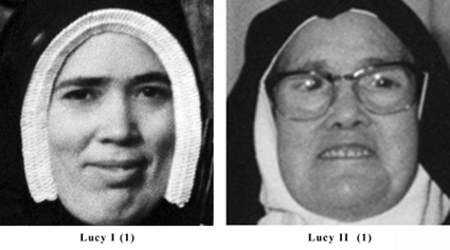The Real Sister Lucy had it, the Imposter did not have it. What is Strabismus?

Strabismus
| Strabismus | |
|---|---|
| Other names | Heterotropia, crossed eyes, squint[1] |
 | |
| A person with exotropia, an outward deviated eye | |
| Pronunciation | |
| Specialty | Ophthalmology |
| Symptoms | Nonaligned eyes[2] |
| Complications | Amblyopia, double vision[3] |
| Types | Esotropia (eyes crossed); exotropia(eyes diverge); hypertropia (eyes vertically misaligned)[3] |
| Causes | Muscle dysfunction, farsightedness, problems in the brain, trauma, infections[3] |
| Risk factors | Premature birth, cerebral palsy, family history[3] |
| Diagnostic method | Observing light reflected from the pupil[3] |
| Differential diagnosis | Cranial nerve disease[3] |
| Treatment | Glasses, surgery[3] |
| Frequency | ~2% (children)[3] |
Strabismus is a condition in which the eyes do not properly align with each other when looking at an object.[2] The eye that is focused on an object can alternate.[3] The condition may be present occasionally or constantly.[3] If present during a large part of childhood, it may result in amblyopia or loss of depth perception.[3] If onset is during adulthood, it is more likely to result in double vision.[3]
Strabismus can occur due to muscle dysfunction, farsightedness, problems in the brain, trauma or infections.[3] Risk factors include premature birth, cerebral palsy and a family history of the condition.[3] Types include esotropia, where the eyes are crossed ("cross eyed"); exotropia, where the eyes diverge ("lazy eyed" or "wall eyed"); and hypertropia where they are vertically misaligned.[3] They can also be classified by whether the problem is present in all directions a person looks (comitant) or varies by direction (incomitant).[3] Diagnosis may be made by observing the light reflecting from the person's eyes and finding that it is not centered on the pupil.[3] Another condition that produces similar symptoms is a cranial nerve disease.[3]
Treatment depends on the type of strabismus and the underlying cause.[3] This may include the use of glasses and possibly surgery.[3] Some types benefit from early surgery.[3] Strabismus occurs in about 2% of children.[3] The term is from the Greek strabismós, meaning "to squint".[4]Other terms for the condition include "squint" and "cast of the eye".[5][6][7] "Wall-eye" has been used when the eyes turn away from each other.[8]
Signs and symptoms[edit]
When observing a person with strabismus, the misalignment of the eyes may be quite apparent. A person with a constant eye turn of significant magnitude is very easy to notice. However, a small magnitude or intermittent strabismus can easily be missed upon casual observation. In any case, an eye care professional can conduct various tests, such as cover testing, to determine the full extent of the strabismus.
Symptoms of strabismus include double vision and eye strain. To avoid double vision, the brain may adapt by ignoring one eye. In this case, often no noticeable symptoms are seen other than a minor loss of depth perception. This deficit may not be noticeable in someone who has had strabismus since birth or early childhood, as they have likely learned to judge depth and distances using monocular cues.[citation needed]However, a constant unilateral strabismus causing constant suppression is a risk for amblyopia in children. Small-angle and intermittent strabismus are more likely to cause disruptive visual symptoms. In addition to headaches and eye strain, symptoms may include an inability to read comfortably, fatigue when reading, and unstable or "jittery" vision





Comments
Post a Comment